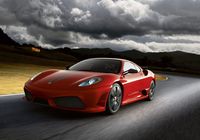University To Study The Ferrari Diet
HOMEBUSH, Australia – February 23, 2009: Ferrari is funding a new university laboratory and its staff to find new methods to put its super cars on a strict diet so that they can maintain their world-beating performance while reducing fuel consumption and cutting exhaust emissions.
“Automotive obesity” has become a significant problem for the car industry as a whole, as cars have put on weight to meet demands for safety, comfort and convenience, leading to increased fuel consumption and higher exhaust emissions as cars have to haul around all this extra weight.
Ferrari is, as ever, at the cutting edge of this new technology and its aim is a staggering one – to produce a car that will set a new performance benchmark, as well as having the style and features of a true Ferrari, yet weigh little more than the most economical car on the Australian market, the Fiat 500 JTD, at 1000 kgs. This will lead to fuel consumption and exhaust emissions dropping by in excess of 40 per cent.
The task is much harder than might be imagined, as the car must still meet safety regulations, it must have the durability and quality of any other car, as well as there being no reduction in refinement, equipment and features as well as noise suppression. The materials and techniques must also be able to be used on production lines and be recyclable at the end of their life.
To make this deep research possible, Ferrari has founded in collaboration with the University of Modena and Reggio Emilia, and its engineering department the “Mille Chili" Laboratory, its name taken from the target project, a 1000 kg super car, the “Mille Chili”. Equipped with hardware, software and chassis from Ferrari to study research projects developed by the faculty's undergraduates, the students can rely on the support of their teaching staff and Ferrari engineers.
As with so much technology that started at Ferrari and which has contributed to cars around the world using less fuel, providing higher levels of safety and reducing emissions, such as sequential manual transmissions and electronic stability control, Ferrari’s cutting edge research and development in weight saving can be expected to benefit all road users.
“It is a great pleasure to inaugurate this laboratory, which will work on a very important issue for the future,” says Ferrari CEO Amedeo Felisa, who started his career as an engineer. “Our experience confirms that constant collaboration between private industry and Universities is a fundamentally important. It provides major rewards for both parties with the University able to work with theoretical issues and new technology, while industry can use these theories and technologies to develop and productionise new ideas.”
Demonstrating its weight loss skills and the potential of the Ferrari diet, Ferrari has already displayed a concept for the Mille Chili super car, while the fastest production Ferrari ever, the Ferrari 430 Scuderia, is also the most economical Ferrari ever and boasts the lowest ever emissions of any Ferrari thanks, in part, to the 100 kg weight loss compared to the standard Ferrari F430.
Ferrari is funding a wide range university and innovation projects at both Italian and foreign universities, with scholarships in areas as diverse as Engineering, Physics, Architecture and Human Studies.



